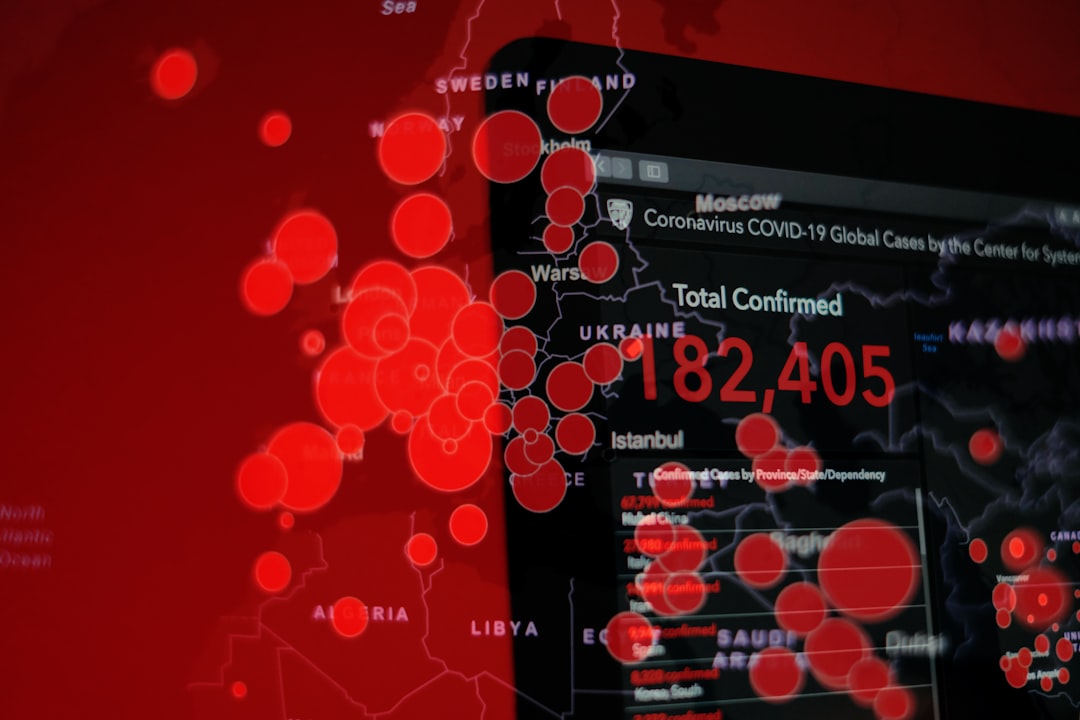

Engage prospects with a scan and streamline customer engagement with FREE QR code marketing tools by Sona – no strings attached!
Create a Free QR CodeFree consultation

No commitment

Engage prospects with a scan and streamline customer engagement with FREE QR code marketing tools by Sona – no strings attached!
Create a Free QR CodeFree consultation

No commitment
In an era where digital threats evolve faster than organizations can respond, network security companies face intense pressure to connect robust cybersecurity solutions with user-friendly access. Legacy access management processes, such as printed codes and complicated manual onboarding, create both physical and digital vulnerabilities that sophisticated attackers can exploit. At the same time, customers and on-site personnel demand seamless, instant connectivity that does not compromise privacy or data integrity.
A persistent challenge for security teams is the inability to track and respond to every high-value access request, particularly when traditional methods miss or fail to identify potential risks. Missing or anonymous access events can lead to missed business opportunities and increased exposure to breaches. When front desk logs, paper forms, or ad hoc badge assignments live outside your CRM, SIEM, or identity systems, your organization loses visibility, context, and the ability to automate next steps.
QR codes have emerged as a powerful tool for network security companies to transform how users, clients, and partners initiate secure connections. Offering a frictionless bridge between physical touchpoints and digital resources, QR code workflows accelerate access, enable dynamic authentication, and unlock new opportunities for secure onboarding and compliance tracking. By placing scannable entry points at the right places and integrating them with identity and analytics platforms, you can turn previously anonymous interactions into verifiable, auditable, and revenue-relevant outcomes.

QR codes are transforming access control and digital onboarding for network security companies, providing a critical link between physical infrastructure and cybersecurity best practices. Many organizations struggle with legacy workflows where high-value visitors are missed due to activities not tracked in the CRM or logs, leading to lost insights and compliance gaps. QR-driven flows can replace printed brochures, clipboard sign-in sheets, and manual guest Wi-Fi passwords with digital processes that validate identity, capture consent, and sync data instantly.
To get the most from QR codes, start by aligning them with priority outcomes, such as reducing time to access, enforcing policy acknowledgement, and increasing attribution for onsite engagement. Then design the experience for the environments where scanning will occur. High-traffic entrances, conference rooms, and device racks are ideal locations, as they concentrate intent and need. Finally, connect scans to your SIEM, CRM, or help desk to ensure every interaction becomes actionable.
Typical use cases include secure check-in flows and QR-based Wi-Fi access that replaces distributed passwords. These changes reduce risk, increase usability, and centralize engagement tracking so that security and sales teams gain shared visibility across the onsite and digital journey.

Network security organizations operate in environments where both connectivity and integrity are critical, but fragmented access systems and siloed data can create dangerous blind spots. A lack of visibility into anonymous traffic means potential leads or threats may go unrecorded, impacting opportunity and risk remediation. The ability to prove who accessed what, when, and why is equally important for audits and compliance, yet paper-based or ad hoc workflows rarely provide this level of proof.
QR codes make the offline-to-online handoff immediate and measurable. Each scan can start a secure workflow that verifies identity, collects consent, and applies policy in real time. By standardizing how users initiate actions, QR codes reduce complexity for visitors and administrators alike, while adding the instrumentation that security teams need to detect anomalies and enforce controls.
These advantages enable more reliable segmentation, fewer missed accounts, stronger compliance posture, and direct attribution between on-premise interactions and business outcomes.

Network security teams benefit from tailored QR code formats that map cleanly to their security and operational needs. The right format depends on the action you want the user to take and the controls you need to apply. In many cases, dynamic formats deliver better governance because they support change management and analytics without reprinting.
For implementation clarity, focus on formats that match common workflows in this vertical, such as onboarding devices and people, distributing secure documentation, and launching support or incident reports. With a centralized platform like Sona QR, you can generate all of these formats, enforce governance, and manage them in one place.
Centralized tools allow quick updates and access control, helping close gaps between changing requirements and printed materials. Dynamic QR codes also enable revocation, link expiration, or policy changes that align with your broader security posture.

Many security companies struggle to identify growth opportunities because engagement data is fragmented across physical locations, devices, and marketing systems. QR codes can standardize how intent is captured at critical touchpoints, giving both security and revenue teams a common view of who engaged and why. When scans are tagged by location, campaign, and device, you can tie offline interest to digital follow-up with a high degree of confidence.
Start with moments where identity verification and information exchange already happen. Entrances, briefing centers, and service interactions are rich with intent, yet they are often tracked poorly or not at all. By placing purpose-built QR codes in those contexts, you can provide an improved experience for the visitor while collecting compliant, useful data for your teams.
Focus on the intersections of compliance, onboarding, and user intent. These are the places where QR codes both remove friction and generate the highest quality signals for segmentation and follow-up.
Inconsistent data capture and unclear segmentation limit personalization and pipeline attribution. QR codes provide a consistent capture mechanism that aligns to your existing workflows while making them faster and more secure. The following high-impact use cases address common friction points across access, compliance, and engagement.
Each use case can be implemented with basic materials such as signage, badges, or equipment labels, then connected to your identity, marketing, and service systems. By instrumenting these moments, you convert lost opportunity into clear signals that guide next actions and improve security outcomes.
These use cases integrate smoothly with SIEM, SOAR, ITSM, and CRM systems. Sona QR helps route scans based on role or location, while logging meaningful metadata that supports both security controls and revenue analytics.
Incomplete or outdated account data creates segmentation and messaging problems. Every QR scan is a verifiable data point that can fuel smarter outreach. When your codes are unique to a location, event, or content type, scan data becomes a powerful proxy for intent. With careful tagging and integration, you can build high-value audiences and automate follow-up across channels.
A good approach maps different codes to specific buyer journeys. For example, an evaluation-stage QR on a SASE whitepaper signals research behavior, while a post-demo QR for pricing information reveals late-stage interest. Both interactions are valuable, but they require different follow-ups and service commitments.
For network security companies, audience distinctions might include practitioners versus executives, product evaluators versus procurement, or existing customers versus net-new prospects. Sona QR can automatically enrich scan data and push segments to your downstream tools to ensure timely and relevant engagement.
Disconnected campaigns yield confusion and wasted resources. QR codes act as connectors that unify print, events, and digital channels while making every touchpoint measurable. When executed thoughtfully, codes do not just link to a page; they launch a crafted journey that reflects context and intent.
Start by embedding QR codes in the marketing materials you already produce. Validate scannability and ensure the destination is mobile optimized, secure, and personalized when possible. Add CTAs that communicate clear value, such as accessing a buyer’s guide, booking a security assessment, or joining a secure customer community.
A centralized platform like Sona QR prevents channel and data silos by managing codes, monitoring performance, and syncing scan data with your CRM, SIEM, and ad systems. This creates a connected offline-to-online funnel that is easy to measure and optimize.
Strong QR deployments combine clear goals, thoughtful design, and rigorous measurement. The following checklist will help you plan and execute with confidence while maintaining the controls your security posture requires.
Identify the most valuable workflow to address. Examples include guest Wi‑Fi onboarding, executive briefing registration, NDA acknowledgement at the front desk, or instant escalation to tiered support. Align each use case to a specific outcome such as reduced wait times, higher conversion to meeting, or improved compliance coverage.
Select the appropriate QR format for your intended action. Static codes are suitable for evergreen, non-tracked assets, while dynamic codes offer analytics, access controls, and destination flexibility that are vital for most security workflows.
Design affects both scannability and trust. Make your codes obviously scannable, on-brand, and paired with a clear promise of value.
Choose placements that mirror your growth and security priorities. Roll out incrementally so you can measure and iterate before scaling.
Measurement closes the loop between scans and outcomes. Use analytics to refine design, message, and placement for continuous improvement.

Full tracking is essential; without it, risk persists and business opportunities vanish. Analytics platforms capture scan details such as timestamp, device type, location, and campaign, transforming raw interactions into insights. When scan data is enriched with identity signals and connected to downstream systems, you can see the complete journey from offline interest to secured access and beyond.
Sona is an AI-powered marketing platform that turns first-party data into revenue through automated attribution, data activation, and workflow orchestration, identifying and enriching visitors, syncing audiences across channels, and unifying attribution with activation for precise, scalable growth.
Integrate real-time scan data with SIEM, CRM, and help desk platforms to enrich user profiles, automate alerts, and attribute engagement to outcomes. For example, a scan at a data center entrance can trigger MFA validation and auto-create a visit log in your CRM. A scan on a device label can pre-fill a service ticket with asset metadata, speeding resolution while maintaining an audit trail.
By connecting scans to secure outcomes and measurable business impact, QR codes become a core part of your performance stack rather than a novelty.
Generic or siloed QR deployments miss valuable data and underperform. To sustain growth, treat QR as a programmable entry point with clear ownership, analytics, and automation. Success depends on designing for context, training staff, and integrating with the systems that run your business.
Aim for quick wins that demonstrate value, such as replacing guest Wi‑Fi passwords with time-bound QR onboarding or enabling QR-based check-in for executive briefings. Once the basics work reliably, expand to advanced use cases such as privileged access requests and context-aware support flows.
Integrating QR codes into operations and client services opens new avenues for secure, efficient, and trackable user experiences. Replace outdated, analog processes with dynamic, data-driven solutions to increase customer satisfaction and extend control over your security perimeter. Companies historically challenged by missed engagement signals or incomplete lead tracking can now gain actionable intelligence from every access point. Each scan becomes an engagement vector and a strategic checkpoint that informs both security and growth.
Adopting these techniques positions organizations to stay ahead of emerging cyber threats. Pilot a secure QR workflow such as guest Wi‑Fi or digital badging, then expand into compliance attestations and support escalations. With Sona QR, you can generate, manage, and measure your first codes in minutes, integrate with your existing stack, and prove value quickly. As you scale, Sona.com helps connect anonymous scans to known buyers and attribute revenue, turning QR campaigns into a reliable engine for secure access and measurable business results. Start creating QR codes for free.
QR codes have revolutionized network security companies by transforming access control and authentication into seamless, trackable, and highly secure processes. Whether it’s streamlining employee and visitor access, enhancing real-time monitoring, or reducing manual security checks, QR codes replace cumbersome protocols with instant, mobile-friendly solutions that boost efficiency and tighten security. Imagine instantly verifying credentials and access rights with a simple scan—eliminating bottlenecks and minimizing risks across your operations.
With Sona QR, you can create dynamic, trackable QR codes tailored for network security needs, updating access permissions instantly without reissuing badges or credentials. Each scan captures critical engagement data, empowering your security teams to monitor access patterns, respond swiftly to anomalies, and optimize security workflows. No more guesswork or outdated systems—just smarter, more secure access management that keeps your network safe and agile.
Start for free with Sona QR today and turn every QR code scan into a powerful tool for secure, efficient, and data-driven access control.
The article highlights Sona QR as a key platform used by network security companies to manage QR code workflows and integrations.
They implement secure QR code workflows that verify identity, collect consent, apply policy controls in real time, educate staff on QR phishing threats, and integrate scan data with SIEM and CRM systems for anomaly detection.
The latest trends include using dynamic QR codes for secure onboarding, replacing legacy manual processes with digital workflows, integrating QR scans with identity and analytics platforms, and leveraging real-time tracking and automation.
They reduce risks by replacing printed passwords with dynamic QR code Wi-Fi onboarding, enforcing policy acknowledgements digitally, enabling real-time audit trails, and integrating scan events with security systems to detect and respond to unauthorized access.
While the article does not specify attack types, it explains that security companies mitigate risks by closing gaps caused by anonymous access, enabling identity verification on scan, enforcing multi-factor authentication, and maintaining detailed audit logs through QR code integrations.
QR codes provide seamless, measurable access control, reduce manual errors, enable dynamic updates, provide real-time analytics, improve cost efficiency, and bridge offline-to-online interactions securely.
They assess current workflows, deploy targeted dynamic QR use cases like Wi-Fi provisioning and digital badging, define success metrics, design strategic placements, and integrate scan data with CRM and SIEM systems for automation and auditability.
Common formats include web links to authentication portals, Wi-Fi access codes with embedded credentials, digital forms for visitor intake or incident reporting, app download links, and vCards for secure contact sharing.
By standardizing the capture of user intent at critical touchpoints, tagging scans by location and campaign, and integrating data with marketing and sales platforms, QR codes enable precise segmentation and targeted follow-up.
Use cases include secure Wi-Fi onboarding, visitor check-in and digital badging, policy training and attestations, privileged user onboarding, and incident reporting with pre-filled forms.
They should choose use cases aligned to business outcomes, select appropriate static or dynamic codes, design branded and clear CTAs, deploy codes in high-impact locations, and continuously track and optimize performance.
Platforms capture scan metadata like timestamp, location, and device type, unify scan data with identity via SSO, visualize end-to-end user journeys, set benchmarks for scan-to-action rates, and close attribution loops with CRM and security systems.
Tips include using unique codes per placement, adding UTM parameters, automating post-scan follow-ups, educating staff and users on benefits and risks, and creatively deploying codes on badges, labels, and collateral.
They embed QR codes in printed collateral, direct mail, events, digital signage, and office signage, ensuring mobile-optimized secure destinations and linking scan data to CRM and advertising platforms for seamless measurement.
Use Sona QR's trackable codes to improve customer acquisition and engagement today.
Create Your FREE Trackable QR Code in SecondsJoin results-focused teams combining Sona Platform automation with advanced Google Ads strategies to scale lead generation

Connect your existing CRM

Free Account Enrichment

No setup fees
No commitment required

Free consultation

Get a custom Google Ads roadmap for your business






Launch campaigns that generate qualified leads in 30 days or less.
